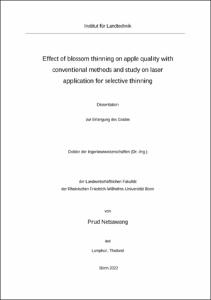Netsawang, Prud: Effect of blossom thinning on apple quality with conventional methods and study on laser application for selective thinning. - Bonn, 2022. - Dissertation, Rheinische Friedrich-Wilhelms-Universität Bonn.
Online-Ausgabe in bonndoc: https://nbn-resolving.org/urn:nbn:de:hbz:5-68027
Online-Ausgabe in bonndoc: https://nbn-resolving.org/urn:nbn:de:hbz:5-68027
@phdthesis{handle:20.500.11811/10308,
urn: https://nbn-resolving.org/urn:nbn:de:hbz:5-68027,
author = {{Prud Netsawang}},
title = {Effect of blossom thinning on apple quality with conventional methods and study on laser application for selective thinning},
school = {Rheinische Friedrich-Wilhelms-Universität Bonn},
year = 2022,
month = sep,
note = {Crop-load regulation by blossom thinning has an important role to improve the fruit quality and mitigate an alternate bearing on apple fruit production. This method aims to reduce excessive flowers to regulate the final fruit yield with marketable fruit quality. Although several techniques of blossom thinning already provide efficient thinning, the development of more effective thinning techniques is still essential to achieve selective thinning and to prevent a negative effect on trees and the environment.
In study 1, the efficacy of three different thinning methods on the regulation of fruit set, June drop, return bloom, fruit quality, fruit yield and the source–sink relationship were investigated. Mechanical, chemical and manual thinning were applied on apple trees cv. ‘Roter Boskoop’ at the Klein-Altendorf field laboratory of the University of Bonn. The results clearly showed that fruit production benefits from crop load management by blossom thinning. All thinning methods in this experiment gave evidence of improvement in fruit quality in terms of fruit size and weight. The fruit yield reduction by manual removal of =50% of flower clusters improved the return bloom as did the mechanical thinning with a rotor speed of 320 rpm. These three methods of thinning provided the optimal fruit yield of 14–18 kg per tree with acceptable fruit size and weight.
Study 2 was undertaken to explore an alternative approach for selective flower removal by applying laser radiation. This study was performed under laboratory conditions at the Institute of Agricultural Engineering, University of Bonn to investigate the efficacy of flower removal by applying laser radiation based on three different factors: the phenological growth stage of the apple flower, laser spot position and laser energy density. The results demonstrate that applying laser radiation can be used as an alternative technique to increase the thinning selectivity. An application of laser radiation with a low energy density of 1.02 J mm-2 to remove flowers was successful during balloon and full bloom stages when the laser spot was in the three positions, a) from the front of a flower cluster (FFC), b) from the side of a flower (FSF) and c) from the front of a flower (FFF). Applying laser radiation on the front of the flower cluster (FFC) during balloon and full bloom stages provided the most suitable condition for selective flower removal. The lowest applicable laser energy density of 1.02 J mm-2 reduced 2–3 flowers in a cluster on average, while the highest applicable laser energy density of 3.06 J mm-2 removed 3–4 flowers on average, i.e. 50% of the flowers on the cluster.},
url = {https://hdl.handle.net/20.500.11811/10308}
}
urn: https://nbn-resolving.org/urn:nbn:de:hbz:5-68027,
author = {{Prud Netsawang}},
title = {Effect of blossom thinning on apple quality with conventional methods and study on laser application for selective thinning},
school = {Rheinische Friedrich-Wilhelms-Universität Bonn},
year = 2022,
month = sep,
note = {Crop-load regulation by blossom thinning has an important role to improve the fruit quality and mitigate an alternate bearing on apple fruit production. This method aims to reduce excessive flowers to regulate the final fruit yield with marketable fruit quality. Although several techniques of blossom thinning already provide efficient thinning, the development of more effective thinning techniques is still essential to achieve selective thinning and to prevent a negative effect on trees and the environment.
In study 1, the efficacy of three different thinning methods on the regulation of fruit set, June drop, return bloom, fruit quality, fruit yield and the source–sink relationship were investigated. Mechanical, chemical and manual thinning were applied on apple trees cv. ‘Roter Boskoop’ at the Klein-Altendorf field laboratory of the University of Bonn. The results clearly showed that fruit production benefits from crop load management by blossom thinning. All thinning methods in this experiment gave evidence of improvement in fruit quality in terms of fruit size and weight. The fruit yield reduction by manual removal of =50% of flower clusters improved the return bloom as did the mechanical thinning with a rotor speed of 320 rpm. These three methods of thinning provided the optimal fruit yield of 14–18 kg per tree with acceptable fruit size and weight.
Study 2 was undertaken to explore an alternative approach for selective flower removal by applying laser radiation. This study was performed under laboratory conditions at the Institute of Agricultural Engineering, University of Bonn to investigate the efficacy of flower removal by applying laser radiation based on three different factors: the phenological growth stage of the apple flower, laser spot position and laser energy density. The results demonstrate that applying laser radiation can be used as an alternative technique to increase the thinning selectivity. An application of laser radiation with a low energy density of 1.02 J mm-2 to remove flowers was successful during balloon and full bloom stages when the laser spot was in the three positions, a) from the front of a flower cluster (FFC), b) from the side of a flower (FSF) and c) from the front of a flower (FFF). Applying laser radiation on the front of the flower cluster (FFC) during balloon and full bloom stages provided the most suitable condition for selective flower removal. The lowest applicable laser energy density of 1.02 J mm-2 reduced 2–3 flowers in a cluster on average, while the highest applicable laser energy density of 3.06 J mm-2 removed 3–4 flowers on average, i.e. 50% of the flowers on the cluster.},
url = {https://hdl.handle.net/20.500.11811/10308}
}






